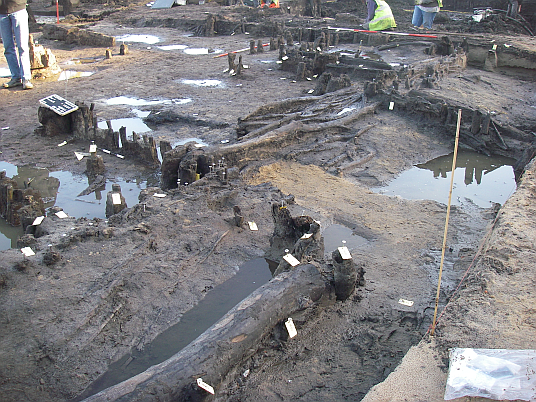NL, Terborg: Archaeologists investigate a big settlement area
In 2010 the Archeodienst Gelderland conducted an archaeological excavation of a settlement area in the historic town centre of Terborg, a city situated in the eastern Netherlands, near the Dutch-German border. The first results of the excavation were spectacular.
In the eastern Netherlands it almost never happens that relicts of the wooden buildings of the first settlement phase are preserved up to the present, because of the sandy soils in this region. Organic matter, like leather or wood will deteriorate quickly in sandy soils a fortiori as it is not preserved by groundwater. In contrast to many other towns in the eastern Netherlands, Terborg was not built on a sandy crest, but on peaty ground. Within this milieu organic matter, such as wooden foundations, plank floorings and framework of the early settlement phases has been well preserved. In the 15th century a town fire devastated the buildings in the excavated area. Afterwards the whole site was heaped by a layer of sand of about 1m in thickness. Thus the remains of the first settlement phases were protected from damage by later building activities. Furthermore these remains were protected from deterioration due to their position underneath ground-water level.

The combination of both factors led to the unique chance to investigate settlement processes which took place in a couple of parcels, continuously, from the very beginnings in the 13th century up to today, in a very comprehensive way! Beyond that, the wooden finds may contain a plenty of information, not only about settlement phases and building methods, but also about the origins of the timber used for construction and possible trade routes related hereto. No comparable research project has been conducted so far in the eastern Netherlands and the Dutch-German border area as well. Thus the project may be able to serve as a model for further research in the future.
Within the scope of a dissertation at the Westfälische Wilhelms-Universtität Münster, Germany, substantial dendrochronological research will be carried out in cooperation with the dendrochronological laboratory of Pressler GmbH. This will be the foundation for the setup of a fine tuned chronological framework in order to reconstruct settlement processes in the excavated area. On the basis of more than 1000 excavated wooden finds it may be possible to get detailed information about the way buildings were constructed and where timber for construction came from. Thus it may also be possible to draw conclusions about the economic networks and local, regional and trans-regional trade routes, at the early phases of the settlement. Due to the interdisciplinary and international approach of the research project the scarce chance comes to existence, to reconstruct housing- and living conditions in the course of centuries in Terborg.
Text and fotographs: W.S. van de Graaf, translation: Sebastian Luke






